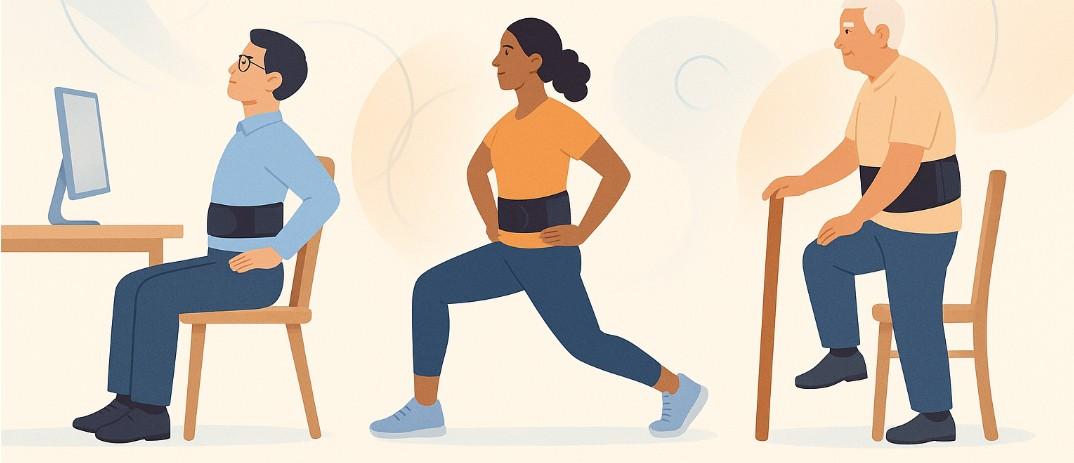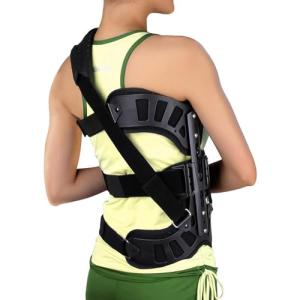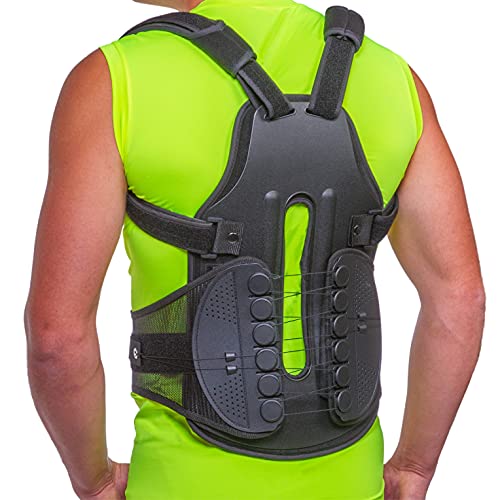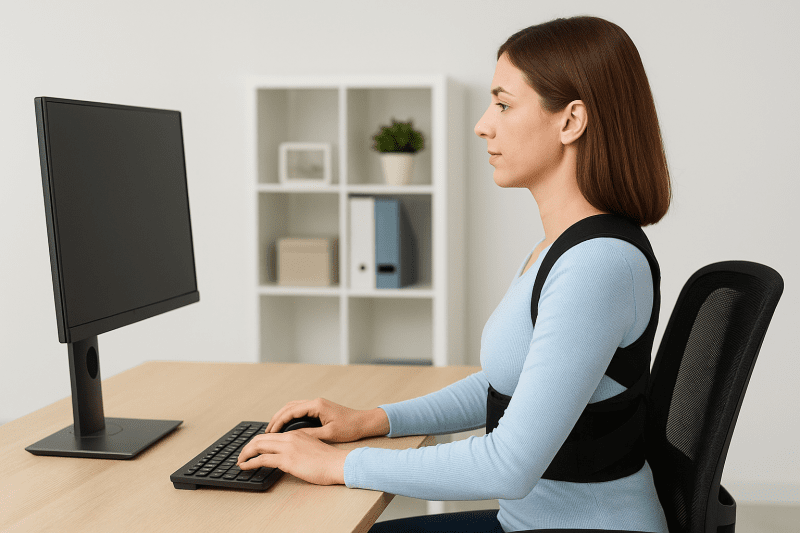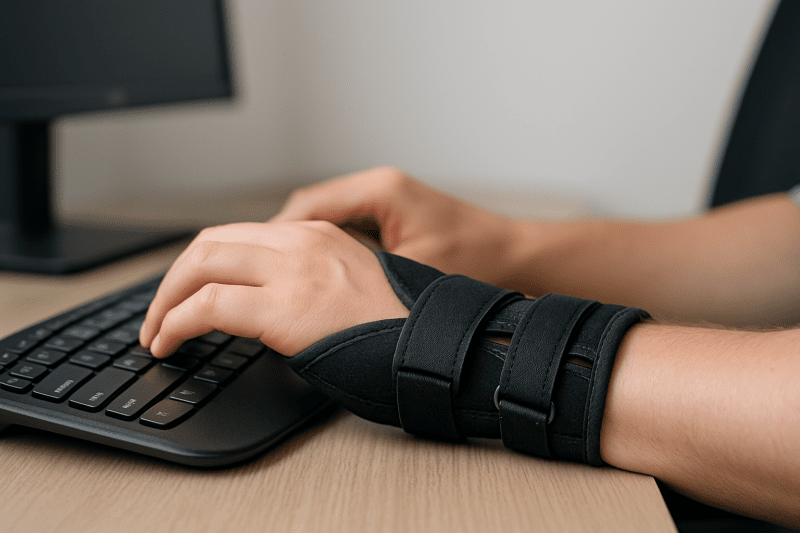Can You Exercise While Wearing a Back Brace?
Yes — in fact, light exercise while wearing a back brace can be one of the safest ways to return to movement. A brace provides external support so your spine stays aligned while the surrounding muscles gently activate. For many people, this creates a sense of stability and confidence that makes movement feel possible again.
A well-fitted back brace can help you:
-
Maintain better posture while you move
-
Reduce unnecessary twisting or overextension
-
Activate your core without straining
-
Move without fear of “tweaking” your back
-
Build strength gradually and safely
That said, the right exercises depend heavily on your lifestyle. A desk worker stuck in a chair all day doesn’t need the same plan as an active adult returning from injury and a senior managing chronic pain needs movements focused on stability, not intensity.
That’s why the routines below are tailored to three distinct lifestyles and mobility needs.
Benefits of Light Exercise While Wearing a Back Brace
Think of gentle exercise + a back brace as a supportive partnership. The brace guides your body into better alignment, and your muscles handle the light work that builds strength and restores mobility.
Some benefits include:
1. Improved Posture and Body Awareness
A back brace encourages a neutral spine, helping you relearn healthier movement patterns — especially for people who sit long hours or move hesitantly after injury.
2. Safe Core Activation
Your core stabilizes with less strain because the brace prevents sudden or excessive movements.
3. Reduced Pain and Stiffness
Light mobility work increases blood flow, which helps ease tension, especially for seniors and desk workers.
4. More Confidence in Movement
Whether you’re worried about reinjury or simply unsure how to move safely, the brace adds reassurance so you can get going again.
Choose the Exercise Plan That Fits Your Lifestyle
Each of the routines below is designed for a specific type of person:
• For desk workers who feel stiff, slumped, and fatigued
• For active adults recovering from a strain or injury
• For seniors who want gentle, stable, comfortable movement
You can skip straight to your section — or try a mix of exercises from each.
Gentle Back Brace Exercises for Desk Workers
For the desk worker — stiffness relief, posture confidence, productivity boost
If you spend hours seated, your back brace can act as a reminder—not a restriction. These exercises help you maintain good posture while strengthening your core and releasing tension.
Primary Goals
-
Reduce stiffness from long sitting
-
Improve posture and core endurance
-
Boost daily comfort and focus
1. Seated Pelvic Tilts
Why it helps:
Sitting all day shuts down your deep core muscles. Pelvic tilts wake them up — and your brace keeps your spine aligned so you don’t over-arch or round.
How to do it:
-
Sit tall with both feet flat.
-
Slowly rock your pelvis forward and back.
-
Keep movements small and controlled.
-
Repeat 10–12 times.
Why this works for you:
It gently restores control of your lower back and helps you reset posture without even standing.
2. Standing Wall Slides
Why it helps:
This move strengthens your upper back — the area that suffers most during long computer sessions.
How to do it:
-
Stand with your back against a wall, brace on.
-
Slide your arms upward like making a “snow angel.”
-
Keep ribs and low back supported by the brace.
-
Do 8–10 slow reps.
Why this works for you:
Your brace reinforces the neutral spine, helping you maintain alignment throughout the movement.
3. Isometric Core Holds
Why it helps:
This strengthens core stability without bending or twisting — great for focus days when your back feels fatigued.
How to do it:
-
Sit or stand tall.
-
Gently brace your core as if tightening a belt.
-
Hold for 5–8 seconds, release, repeat 10 times.
Why this works for you:
It improves workday posture endurance without straining or requiring floor space.

4. Desk-Break Mobility Flow (1–2 minutes)
A quick reset for your spine:
-
Neck turns: Right, left — 5 each
-
Shoulder circles: 8 forward, 8 back
-
Chest opener stretch: 15 seconds
-
Gentle standing twist (very small range): 5 per side
Why this works for you:
Micro-movements reduce stiffness and keep your energy up — no workout clothes needed.
Safe Strength-Building Exercises for Active Adults Recovering From Injury
For the active adult recovering from injury — injury-safe movement, athletic confidence, smart training
You want to stay active — but you also want to avoid the “one wrong move” feeling. These exercises help you rebuild strength safely while your brace keeps your spine stable.
Primary Goals
-
Restore movement confidence
-
Rebuild core and lower-body strength
-
Prevent reinjury while staying active
1. Supported Glute Bridges
Why it helps:
Glute strength protects your spine, and your brace prevents excessive arching.
How to do it:
-
Lie on your back with knees bent.
-
Lift your hips slowly.
-
Pause at the top for one breath.
-
Lower with control.
-
Aim for 10–15 reps.
Why this works for you:
Reactivates your posterior chain — the foundation of strong, safe movement.
2. Step-Ups With Stability Focus
Why it helps:
Builds leg strength while reinforcing balanced, supported movement.
How to do it:
-
Use a low step or stair.
-
Step up slowly, keeping hips level.
-
Step down with control.
-
Do 8–10 reps per side.
Why this works for you:
It mimics daily motions and keeps your body moving with athletic alignment.
3. Resistance Band Dead-Bug Variations
Why it helps:
Deep-core engagement without spinal strain — especially helpful when fear of reinjury is high.
How to do it:
-
Lie on your back, brace on.
-
Hold a resistance band overhead for stability.
-
Extend opposite arm and leg.
-
Keep ribs down and spine supported.
-
Perform 6–10 reps per side.
Why this works for you:
It strengthens your core in a controlled, brace-supported way that feels safe.
4. Slow, Controlled Bird-Dog
Why it helps:
A classic stability exercise that builds core endurance and reduces back strain.
How to do it:
-
Start on hands and knees.
-
Extend opposite arm and leg.
-
Keep your hips level.
-
Move slowly — super slow is best.
-
Repeat 6–8 reps per side.
Why this works for you:
The brace prevents overextension — a common mistake that causes back pain.
Gentle, Pain-Reducing Back Brace Exercises for Seniors
For seniors with pain — comfort, stability, independence
These exercises are low impact, joint-friendly, and focused on confidence and daily function.
Primary Goals
-
Reduce pain
-
Improve stability and balance
-
Maintain independence in daily tasks
1. Chair-Assisted Marching
Why it helps:
Improves hip mobility and circulation without strain.
How to do it:
-
Sit tall with brace on.
-
Slowly lift one knee, then the other.
-
March for 20–30 seconds.
Why this works for you:
Great as a warm-up and helps ease daily stiffness.
2. Side-to-Side Weight Shifts
Why it helps:
Improves balance and teaches your body to stabilize — especially important for fall prevention.
How to do it:
-
Stand holding a counter or chair.
-
Shift weight gently right to left.
-
Keep movements small and slow.
-
Do 10–12 shifts.
Why this works for you:
Builds safe, functional stability without tiring you.
3. Gentle Standing Back Extensions
Why it helps:
Relieves back tightness and encourages upright alignment.
How to do it:
-
Hold a counter or sturdy surface.
-
Slowly lean backward as you extend slightly.
-
Stay within a small, pain-free range.
-
Repeat 8–10 times.
Why this works for you:
The brace supports your spine while you move through a soothing stretch.
4. Mini Walk Intervals
Why it helps:
The simplest, safest whole-body movement.
How to do it:
-
Walk for 1–2 minutes.
-
Rest for 30 seconds.
-
Repeat 2–3 intervals.
Why this works for you:
Your brace adds stability so you can walk comfortably and confidently.
Safety Guidelines for Exercising With a Back Brace
Your back brace is a tool — not a permanent solution. Use it to create safety and confidence, not as a substitute for core strength.
Universal Guidelines
-
Start with small ranges of motion.
-
Stop immediately if you feel sharp pain.
-
Keep movements slow and controlled.
-
Use your brace for support, not exertion.
-
Keep breathing — don’t hold your breath.
Persona-Specific Notes
Desk Workers:
If your back gets tired after long sitting, start with mobility exercises before core work.
Active Adults:
If you’re returning from a strain or sprain, avoid sudden bending or twisting, especially under load.
Seniors:
If you use a cane or walker, perform exercises near a stable surface and prioritize balance.
Final Tips + Next Steps
Light movement with a back brace is one of the safest, most encouraging ways to rebuild strength, restore posture, and reduce stiffness at any age.
Whether you’re working at a desk, rebuilding athletic confidence, or moving through chronic pain — the right exercises can help you feel more stable, mobile, and in control.
Your movement matters — and with a little support, you can move better every day.
Need a back brace? Check out our guide on how to choose the right size back brace.
